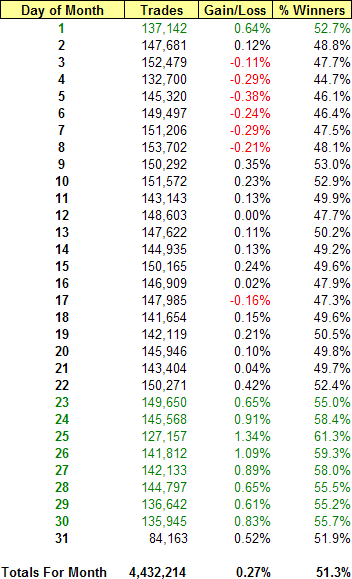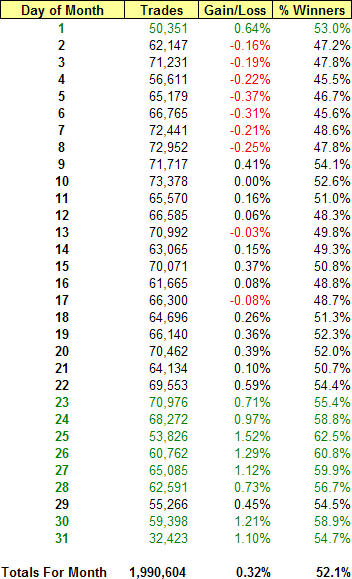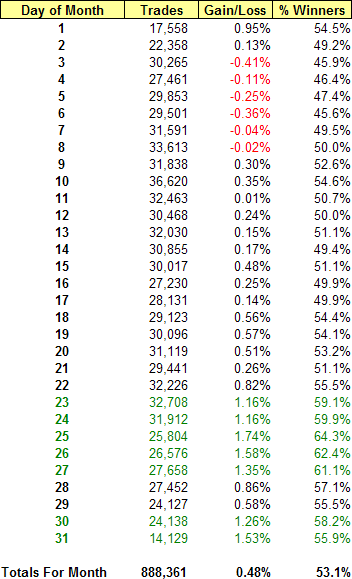When Do Money Managers Like to Buy Stocks? Trading and the End of the Month
Do money managers pile into the stocks at the end of the month in anticipation of 401k and savings money coming in? Well it looks like they do…big time!
Click here to order your copy of The VXX Trend Following Strategy today and be one of the very first traders to utilize these unique strategies. This guidebook will make you a better, more powerful trader.
In 1999, Kevin Haggerty wrote about this phenomenon on the TradingMarkets site. Kevin had just retired as the head of trading for Fidelity Capital Markets, and he discussed the “end-of-the month” phenomena. Up until that time, I had not heard about it nor had seen anyone else write about this.
Since Kevin first mentioned it, I and others have observed it time after time, especially when a stock was rising (meaning above its 200-day moving average).
Recently we decided to look further into this. We decided to see if we could quantify and potentially profit from the behavior. The findings were a bit eye-opening, and I’ll share them with you today.
We looked at over seven million trades going back to January 1995*. We then broke these trades down to the day of the month, meaning we asked “if we bought every stock today, how would we have done over the next 5 trading days?”
We did this for every day of the month for every stock that was trading in a longer-term uptrend, meaning above its 200-day moving average.
Here are the some notes of our findings:
- The average gain for all days (meaning you randomly bought a stock and held it for five days) when it was above its 200-day MA from January 1995-September 2006 was 0.27%.
- Now, let’s look at what happens as we start approaching month end. The average gains rise…significantly. On the 23rd day of the month, the average gain for these stocks more than doubles. On the 24th it triples. On the 25th it almost quadruples! And this type of behavior holds through the end of the month (see table below).
- Let’s go further. Let’s look what happens at the early part of the next month. In spite of a strong upward move in stock prices over the past 11 3/4 years, stocks on average have “lost money” for the six consecutive days from the 3rd through the 8th. Money spent is money spent, and it looks like the fund managers spent their money near the end of the previous month.
- And now let’s go even further and look at something which is even more eye-opening. Let’s look at what happens after a stock drops the previous day. The returns for those stocks go up even more near months-end. And if the stock has dropped two days in a row, the gains become extreme. On the 25th and the 26th, the stocks which have dropped two days in a row have risen more than 1.5% on average over the next 5 trading days. Annualize that out. One can make a heck of a living with returns like this.
- More to number 4. After a stock has dropped two days in a row going into the 25th, 26th and 27th day of the month, more than 60% of the stocks have closed higher five trading days later. Markets are efficient…uh huh.
Kevin was right. And considering his position in the trading world, he certainly had the opportunity of seeing this behavior first-hand. Over the past 11 3/4 years, stocks have been much stronger near months-end than they have been any other time of the month. And, stocks which have dropped a day or two near the end of the month, have out-performed even more (think about what happened this past Tuesday morning after many stocks dropped two days in a row). The fund managers like to buy near months end. And it looks like they especially like to buy stocks as cheap as possible near months end.
Baseline Days of the Month, Above 200-Day MA, 5-Day Hold Days which have outperformed by a 2:1 margin or greater are in green.

1 or More Down Closes, Above 200-Day MA, 5-Day Hold Days which have outperformed by a 2:1 margin or greater are in green.

2 or More Down Closes, Above 200-Day MA, 5-Day Hold Days which have outperformed by a 2:1 margin or greater are in green.

This research can go much further. The size of the drop, ETF and futures trading, short selling, pairs trading, combining PowerRatings with the day of the month, further intra-day drops, etc. are all there for a deeper look.
In the coming weeks I’ll share some of this research with you here on the TradingMarkets site.
Have a great week trading!
Larry Connors
*Our research looked at 7,050,517 trades since Jan 1, 1995. We applied a price and liquidity filter that required all stocks be priced above $5 and have a 100-day moving average of volume greater than 250,000 shares.
Larry Connors is CEO and Founder of TradingMarkets.com.
